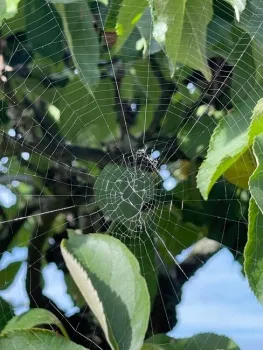
Spiders usually prefer to hide, however, we often become aware of their presence due to their webs. Spiders who make webs generally do so to catch prey.
Spider Web Material
Spider webs are among the most incredible feats of engineering in nature. Made of silk, they are highly flexible, extremely stretchable, and unbelievably strong, being five times as strong as steel.
The silk is produced from spinneret glands located at the tip of their abdomen. Different species have different numbers of spinnerets, ranging from two to eight. There are different glands to produce threads for specific purposes – for example, a safety line, sticky silk for trapping prey, or fine silk for wrapping their prey. There are seven different silk glands, but no species has all seven.
Variety of Webs
Many spiders are classified by the webs they weave. Here are five common types of webs you may see around your home or garden:
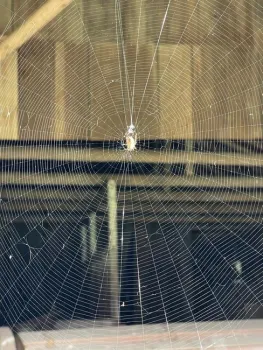
Orb Web – A common, recognizable and often symmetrical web. Primarily associated with the family Araneidae, they are generally known as orb-weavers. Found chiefly outside, orb webs are comprised of a strong external framework which is joined in the center to create spokes. The spokes are linked together with concentric, sticky elastic thread to create a large surface area for capturing prey. Orb spiders have five different silk glands, the most of any group. The spider rests at the center or edge of the web. Since they have poor eyesight, they depend on vibrations to locate prey that has become entangled. The webs are constructed in areas with significant flying insect traffic and can capture upwards of 250 insects per day! There are about 200 species in North America, who are generally non-aggressive. A local example is the Western spotted orb weaver (Neoscona oaxacensis).
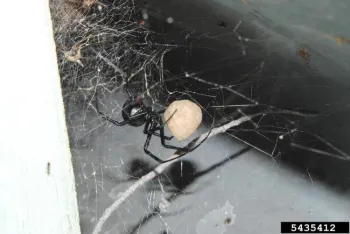
Tangle Web/Cobweb – These are often in areas that see little traffic. These disorganized webs tend to collect a lot of dust and dirt, adding to their messy appearance. Generally anchored to the top of a structure with many threads hanging downward, there are sticky droplets at the end of the hanging strings at floor level. When an insect walks across the thread it is concurrently stuck and lifted into the web by a tightening thread to be consumed by the spider. Tangle webs are predominately made by harmless house spiders in the Theriidae family. The Western black widow (Latrodestus hesperus)is an infamous venomous exception.
Funnel Weaver – As the term suggests, this web is shaped
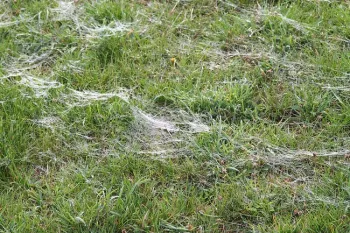
like a funnel. The threads span over a range of distances, meeting in the middle where they form a trampoline-like tubular hole. Insects walk across the mat-like web, getting tangled up. When it senses a vibration the funnel weaver spider rushes out of its concealed hole and quickly subdues its quarry. Often called grass spiders, they are members of the Agelenidae family, funnel weavers can be inside or outside.
Sheet Web – These hammock-like webs are draped over grass, bushes and other structures, with some being very flat over grass and others are dome-shaped. The spider hangs upside down on the web and ambushes any insects that walk below. Flying insects can also hit the threads and drop down to the spider. Unlike most web structures, when these webs are damaged, they are quickly patched up by the spider, so they tend to be permanent constructions. Sheet web spiders are from the Linyphiidae family, which is the largest family of web spinning spiders. Also known as dwarf spiders, most are extremely small and are seldom seen, posing little threat to humans.
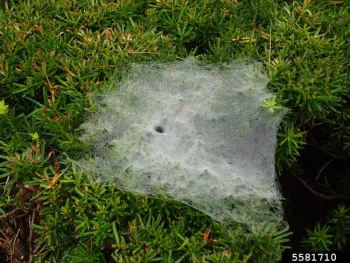
Some Other Uses for Spider Silk
Even spiders who do not make webs to catch prey will create silk. Some examples of other uses:
Reproduction: Mature males make sperm webs to move sperm to their copulatory organs, for transfer to female just prior to mating. These are constructed and destroyed quickly. Females make egg sac webs to wrap their fertilized eggs (which can range from two to 1,000 per sac).
Molting Mat - Predominantly created by tarantulas, these thick mats are laid on the ground where the tarantula flips onto its back to molt its exoskeleton which has become too small for its growing body.
Drag Line – Most people have seen a spider hanging down from a drag line. A safety anchor, it prevents a spider from falling too far, allowing it to drag itself up to the previous position.
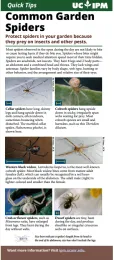
Ballooning – A means of mass distribution of spiderlings and small adults. After climbing to a relatively high spot, the spider points its abdomen upwards and pulls out one to several threads. Air or electrostatic currents carry the threads skywards with the spider attached, transporting it long distances. Fall is a prime time for spider ballooning since many species hatch in large numbers this time of year.
Protect and Appreciate These Master Weavers
Many people are afraid of spiders, despite the fact most are harmless and avoid humans. They are vital beneficial creatures due to their role as predators of insects and other arthropods. Using pesticides as a means of controlling spiders is generally ineffective unless you see the spider and directly spray it. Better methods of control are reducing places for them to hide. See UC IPM Quick Tips publication, Common Garden Spiders at https://ipm.ucanr.edu/legacy_assets/PDF/QT/qtcommongardenspiders.pdf
Halloween and Spider Webs
It is recommended not to decorate your yards during Halloween with artificial spider webs. Beneficial insects such as bees, praying mantis, and even small birds like hummingbirds, can become trapped in them.

Denise Godbout-Avant has been a UC Master Gardener in Stanislaus County since 2020
References and Resources
Widow Spiders and their Relatives, UC IPM
https://ipm.ucanr.edu/PMG/PESTNOTES/pn74149.html
Spiders, UC IPM https://ipm.ucanr.edu/PMG/PESTNOTES/pn7442.html
Wikimedia photo attribution - by Stephen Michael Barnett - https://www.flickr.com/photos/httpwwwflickrcomphotostopend/507502408/in/photolist-8ToHtF-fVRNmy-4YTxhz-oQNEFP-apnXxR-5rgDrW-gCS4ex-btgaVP-LR5Mw-KZm9V-awHMdi-KZm8R-KZm92-ogLQj7-oiNCYK-o2jekP-o2kgpK-Vk7K6-bwZcC1-9wi3ax/, CC BY 2.0, https://commons.wikimedia.org/w/index.php?curid=37513886

